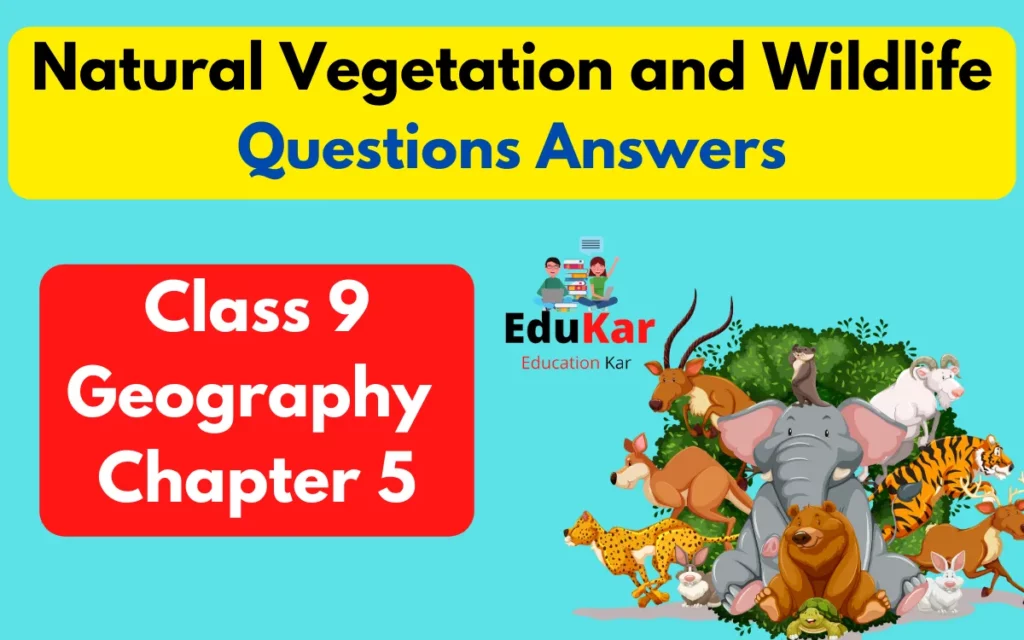| Name | Natural Vegetation and Wildlife |
| Type | Chapter |
| Class | 9th |
| Subject | Geography |
| Board | CBSE (NCERT) |

Natural vegetation refers to the plants and trees that grow in a particular region without human intervention. It is determined by factors such as climate, soil, and topography. Natural vegetation can be categorized into different types, such as tropical rainforests, deciduous forests, coniferous forests, and grasslands.
Tropical rainforests are found in areas near the equator and are characterized by high rainfall and a warm climate. They are home to a wide variety of plant and animal species, including many rare and endangered species.
Deciduous forests are found in areas with a temperate climate, and are characterized by the shedding of leaves in the fall. They are home to a diverse range of plant and animal species, including many types of birds, mammals, and reptiles.
Coniferous forests are found in areas with a cold climate and are characterized by trees that have needle-like leaves. They are home to a wide variety of plant and animal species, including many types of birds, mammals, and reptiles.
Grasslands are found in areas with a moderate climate and are characterized by large areas of grasses and other herbaceous plants. They are home to a wide variety of plant and animal species, including many types of birds, mammals, and reptiles.
Wildlife refers to the non-domesticated animals that live in a particular region. It includes a wide variety of species, such as mammals, birds, reptiles, amphibians, fish, and insects. Wildlife plays a crucial role in maintaining the ecological balance of an ecosystem and is vital for maintaining biodiversity. However, human activities such as habitat destruction, pollution, and overhunting have led to the decline of many wild animal populations. It is important to conserve natural vegetation and wildlife in order to preserve the ecological balance and biodiversity of the earth.
Q1: Choose the right answer from the four options given down below:
a) To which one of the following types of vegetation does rubber belong to?
- Tundra
- Himalayan
- Tidal
- Tropical Evergreen
Ans: Tropical Evergreen
b) Cinchona trees are found in the areas of rainfall more than
- 100 cm
- 70 cm
- 50 cm
- Less than 50 cm
Ans: 100 cm
c) in which of the following state is the Simlipal bio-reserve located?
- Punjab
- Delhi
- Odisha
- West Bengal
Ans: Odisha
d) Which one of the following bio-reserves of India is not included in World network of bioreserve?
- Manas
- Gulf of Mannar
- Nilgiri
- Nanda Devi
Q2: Answer the following questions briefly:
I: What factors are responsible for the distribtution of plants and animals in India?
Ans: India is one of the twelve mega biodiversity countries of the world. The various factors responsible of plants and animals (Flora and Fauna) in India are –
- Relief features including land and soil type.
- Climate, which includes temperature, photoperiod and precipitation.
II. What is a bio-reserve? Give two examples?
Ans: Bio-reserve are sites established by countries and recognised under UNESCO’s Man and Biosphere (MAB) programme. They are established to promote sustainable development based on local community efforts and sound scientific principles. Examples of bio-reserves are the Nilgiris and Nanda Devi.
III. Name two animals having habitat in tropical and montane type of vegetaion.
Ans:
a) Animals having habitat in tropical type of vegetation are elephants, monkeys, rats etc.
b) Animals having habitats in montane types of vegetation are spotted deer, Kashmir stag, antelope etc.
Q3: Write the difference between:
I. Flora and Fauna
| Flora | Fauna |
|---|---|
| The term ‘flora’ is used to denote plants species of a particular region or period. | The term ‘fauna’ is used to denote species of animals. |
| Flora remains at one place. | Fauna moves from one place to another. |
| About 47,000 plants species are found in India. | About 90,000 species of animals are found in India. |
| They make their food by photosynthesis. | They cannot make their own food. Herbivore animals are dependent on flora for food and some are dependent on other animals for food. |
II. Tropical Evergreen and Decidious forests.
| Tropical Evergeen Forests | Tropical Decidious Forests |
|---|---|
| They grow in areas of heavy rainfall which is 200 cm and above. | They grow in areas receiving between 200 and 70 cm. |
| There is no definite time for trees to shed their leaves | The trees leaves for about 6 to 8 weeks in dry summer. |
| Ebony, Mahogany, Rosewood, Rubber and Cinchona are the important trees of these forests. | Teak, Bamboo, Sal, Shisham, Sandalwood, Khair, Kusum, Arjun, Peepal and Neem are the important trees of these forests. |
| Commin animals found in these forests are Leur, Monkeys, Deer and One-horned rhinoceros. | Common animals found in these forests are Lion, Deer, Tiger and Elephant. |
Q4: Name different types of Vegetation found in India and describe the vegetation of high altitudes.
Ans: The different types of vegetations found in INdia are ;
- Tropical Evergreen or Rainforests.
- Tropical Deciduous or Monsoon Forests.
- Tropical Thorn Forests and Scrub.
- Montane Forests.
- Mangrove Forests or Tidal Forests.
The types of vegetation found at the high altitudes is Montane forest. There is a successive of natural vegetation belts, as per successive change in altitude.
Q5: Quite a few species of plants and animals are endangered in India. Why?
Ans: Endangered species of plants and animals are those which face the danger of getting extinct. About 1300 plant species and quite a few animal species have been found to be endangered species in India.
The main cause for this endangerment o plants and animals are:
- Pollution due to chemical and industrial wastes.
- Reckless cutting of plants and trees to bring land under cultivation, expanding industrialization and habitation etc.
- Hunting by greedy hunters for commercial purposes.
- Increasing population.
- Introduction of alien species causing imbalance in the ecosystem.
Q6: Why has India a rich heritage of Flora and Fauna?
Ans: India has all the major physical features like topography varying from mointains, plains, deserts, plateaus, islands etc. The different regions of the country have different soil types.
India has an essentially monsoon type of climate, it has great variations in temperature and humidity across the country.
Each of the factors responsible for the diversity in flora and fauna such as land, soil, temperature, photoperios, precipitation, etc are varying across the length and breath of the country. As a result, India has got rich heritage of flora and fauna.
Natural Vegetation and Wildlife Extra Important Question Answers:
Q1: Whicha are two factors on which the growth of vegetation mostly depends?
Ans: The growth of vegetation depends on temperature and moisture.
Q2: Which are the three broad categories of natural vegetation?
Ans: The three broad categories of natural vegetation are-
- Forests.
- Grasslands.
- Shrubs.
Q3: Name the two hardwood tress commonly found in tropical evergeen forest?
Ans: The two hardwood tress commonly found in tropical evergeen forest are Rosewood and Ebony.
Q4: In which part of world are tropical decidious forest found?
Ans: Tropical decidious forest are found in :
- Large part of India.
- Northern Australia.
- Central America.
Q5: In which climate conditions are citrus fruits cultivated?
Ans: Citrus fruits are cultivated in hot, dry, summers and mild rainy season.
Q6: Mention the uses of Coniferous forest?
Ans: Woods of Coniferous forest are useful for making pulp, which is used for manufacturing paper and newsprint.
Q7: In which part of the world is seasonal grassland found?
Ans: Seasonal grassland is found in Mid latitudinal zone and in the interior parts of continents.’
Q8: Which type of vegetation does rubber belong?
Ans: Rubber belongs to Tropical rain forest.
Q9: How many species of plants are found in India?
Ans: About 47000 types of species of plants are found in India.
Q10: How many species of organisms are found in India?
Ans: About 90,000 species of organisms are found in India.
Q11: What was the percentage of Forests in India in 2001?
Ans: Percentage of forests in India in 2001 was 20.55%.
Q12: Which forests are the ost widely spread in India?
Ans: Tropical Decidious forest.
Q13: What types of forests are found in areas with tide ebb?
Ans: Mangrove forest
Q14: Sundari trees are found in the delta region of which rivers?
Ans: In the delta of the Ganges Brahmaputra rivers.
Q15: Where are Tigers and Lions found in India?
Ans: Tiger: Sundarbans Delta (West Bengal)
Lions : Gir (Gujarat)
Q16: Which animal is only found in India?
Ans: Alligator is the animal only found in India.
Q17: When was the Indian Wildlife Protection Act implemented?
Ans: In 1972.
Q18: How many National parks and Biosphere Reserve are there in India?
Ans: There are 105 National Parks snd 14 Reserve parks in India.
Q19: What do you mean by Indigenous vegetation?
Ans: The vegetation which is Indian in origin is called Indigenous vegetation.
Q20: What do you mean by Foreign vegetation?
Ans: The vegetation which has come to India from abroad, it is called Foreign vegetation.
Q21: What is Virgin vegetation?
Ans: Virgin vegetation refers to a plant community which has grown naturally without human aid and has been left undisturbed by humans for a long time.
Q22: What are the direct advantages of forests?
Ans: The direst advantages of forests are:
- We obtain wood or fuel.
- Many types of herbs are obtained from forests.
- Forest based industries get the raw material from the forests.
- Forests provide shelter to wildlife.
- Forests provide pastures to animals.
Q23: What are the indirect advantages of forests?
Ans: The indirest advantages of forests are:
- Forests keep the environment clean.
- Forests are helpful in bringing rain.
- Forests helps in prevention of floods.
- Forests prevents soil erosion.
- Forests enhance natural beauty.
Match the Follwing:
- Walrus – Apolar animal
- Cedar – Softwood trees.
- Olives – A citrus fruit.
- Elephants – An animal of Tropical decidious forest.
- Campos – Tropical grassland of Brazil.
- Downs – Temperature grassland of Australia.





